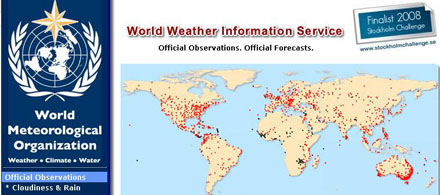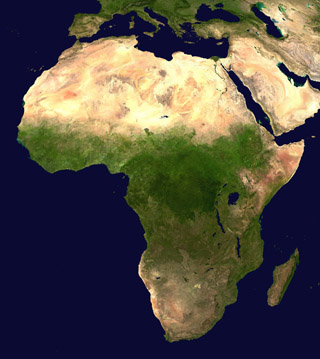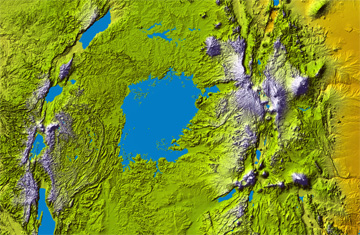Navigation
Africa Weather Information Network Launched by the United Nations
An innovative UN, public-private partnership is launched the “Weather Info for All” initiative to improve Africa’s weather monitoring network in the face of the growing impact of climate change.
 |
| The World Weather InformThe World Weather Information Service (WWIS) website operated by the Hong Kong Observatory (HKO) on behalf of the UN World Meteorological Organization (WMO) which won the prestigious Stockholm Challenge Award 2008 in the Environment category. |
An innovative UN, public-private partnership is launched the “Weather Info for All” initiative to improve Africa’s weather monitoring network in the face of the growing impact of climate change.
 |
| Africa seen from satellite. An orthographic image from NASA. |
About 5,000 new automatic weather stations are set to be deployed across Africa, under a climate change initiative announced on June 18, 2009 by the United Nations World Meteorological Organization, the Global Humanitarian Forum, the Earth Institute at Columbia University, and mobile telecommunications companies Ericsson and Zain.
Highlights:
- Global Humanitarian Forum (GHF), Ericsson, the World Meteorological Organization, and Zain to deploy up to 5,000 automatic weather stations at cellular sites across Africa, where less than 300 are reporting today
- Partnership will increase dissemination of weather information via mobile phones to users and communities, including remote farmers and fishermen
- First 19 stations deployed more than double Lake Victoria region weather monitoring, where 5,000 people die every year due to storms and accidents
- A recent Global Humanitarian Forum report estimated that climate change is responsible for some 300,000 deaths each year and over 100 billion US dollars worth of economic losses, mainly because of shocks to health and agricultural productivity. Sub-Saharan Africa accounts for close to a quarter of these losses, and is the region at the most immediate risk of droughts and floods. Agricultural yields in some areas are expected to fall by 50% as early as 2020.
- The Global Humanitarian Forum initiated this collaboration in response to Africa’s severe gap in weather information highlighted at the Forum’s first annual event.
Sub-Saharan Africa is the region facing the most immediate risk of droughts and floods due to climate change, according to a recent Global Humanitarian Forum report. Agricultural yields in some areas are expected to fall by 50 per cent as early as 2020.
The 5,000 automatic weather stations will be installed at new and existing mobile network sites throughout Africa over the coming years, aiming to increase dissemination of weather information via mobile phones that can reach the continent’s most remote communities. There are only 300 reporting today according to the World Meteorological Organization.
The partnership will increase dissemination of weather information via mobile phones to users and communities, including remote farmers and fishermen.
Topography of Lake Victoria. Image catalogued by Jet Propulsion Lab of the United States National Aeronautics and Space Administration (NASA).
The first 19 stations deployed will more than double Lake Victoria region weather monitoring, where 5,000 people die every year due to storms and accidents.
At the launch in Geneva, former UN Secretary-General Kofi Annan, President of the Global Humanitarian Forum, said “This is a great example for twenty-first century collaborative humanitarian and development work between public and private sectors.”
Through its Mobile Innovation Center in Africa, Ericsson will develop mobile applications to help communicate weather information developed by National Meteorological and Hydrological Services (NMHSs) via mobile phones.
“The massive growth of mobile subscribers in Africa is the perfect opportunity for the telecoms community to collaborate with national partners to strengthen weather networks and systems across the continent,” said Carl-Henric Svanberg, President and CEO of Ericsson.
The initial deployment, already begun in Zain networks, focuses on the area around Lake Victoria in Kenya, Tanzania and Uganda. The first 19 automatic weather stations installed will double the weather monitoring capacity of the Lake region.
Approximately 70 per cent of Africans rely on farming for their livelihood. Meteorological information will become increasingly critical as changing weather patterns render obsolete traditional knowledge relating to agriculture that African farmers have relied on for centuries.
“For food production, almost every decision is linked to weather, climate and water parameters,” said Michel Jarraud, Secretary-General of the WMO. “Working through NMHSs, WMO will identify weather information needs, advise on technical requirements and help disseminate the information. This initiative may prove to be one of the most important for African meteorology in decades.”
________________
This article is from a UN News Centre press release of June 18, 2009 and information from the United Nations World Meteorological Organization.
Note:
Visit related articles on the Horizon Solutions Site:
African Environment Ministers Reach Significant Climate Change Accord
Search
Latest articles
Agriculture
- World Water Week: Healthy ecosystems essential to human health: from coronavirus to malnutrition Online session Wednesday 24 August 17:00-18:20
- World Water Week: Healthy ecosystems essential to human health: from coronavirus to malnutrition Online session Wednesday 24 August 17:00-18:20
Air Pollution
- "Water and Sanitation-Related Diseases and the Changing Environment: Challenges, Interventions, and Preventive Measures" Volume 2 Is Now Available
- Global Innovation Exchange Co-Created by Horizon International, USAID, Bill and Melinda Gates Foundation and Others
Biodiversity
- World Water Week: Healthy ecosystems essential to human health: from coronavirus to malnutrition Online session Wednesday 24 August 17:00-18:20
- Mangrove Action Project Collaborates to Restore and Preserve Mangrove Ecosystems
Desertification
- World Water Week: Healthy ecosystems essential to human health: from coronavirus to malnutrition Online session Wednesday 24 August 17:00-18:20
- UN Food Systems Summit Receives Over 1,200 Ideas to Help Meet Sustainable Development Goals
Endangered Species
- Mangrove Action Project Collaborates to Restore and Preserve Mangrove Ecosystems
- Coral Research in Palau offers a “Glimmer of Hope”
Energy
- Global Innovation Exchange Co-Created by Horizon International, USAID, Bill and Melinda Gates Foundation and Others
- Wildlife Preservation in Southeast Nova Scotia
Exhibits
- Global Innovation Exchange Co-Created by Horizon International, USAID, Bill and Melinda Gates Foundation and Others
- Coral Reefs
Forests
- NASA Satellites Reveal Major Shifts in Global Freshwater Updated June 2020
- Global Innovation Exchange Co-Created by Horizon International, USAID, Bill and Melinda Gates Foundation and Others
Global Climate Change
- World Water Week: Healthy ecosystems essential to human health: from coronavirus to malnutrition Online session Wednesday 24 August 17:00-18:20
- Mangrove Action Project Collaborates to Restore and Preserve Mangrove Ecosystems
Global Health
- World Water Week: Healthy ecosystems essential to human health: from coronavirus to malnutrition Online session Wednesday 24 August 17:00-18:20
- More than 400 schoolgirls, family and teachers rescued from Afghanistan by small coalition
Industry
- "Water and Sanitation-Related Diseases and the Changing Environment: Challenges, Interventions, and Preventive Measures" Volume 2 Is Now Available
- Global Innovation Exchange Co-Created by Horizon International, USAID, Bill and Melinda Gates Foundation and Others
Natural Disaster Relief
- STOP ATTACKS ON HEALTH CARE IN UKRAINE
- Global Innovation Exchange Co-Created by Horizon International, USAID, Bill and Melinda Gates Foundation and Others
News and Special Reports
- World Water Week: Healthy ecosystems essential to human health: from coronavirus to malnutrition Online session Wednesday 24 August 17:00-18:20
- STOP ATTACKS ON HEALTH CARE IN UKRAINE
Oceans, Coral Reefs
- World Water Week: Healthy ecosystems essential to human health: from coronavirus to malnutrition Online session Wednesday 24 August 17:00-18:20
- Mangrove Action Project Collaborates to Restore and Preserve Mangrove Ecosystems
Pollution
- Zakaria Ouedraogo of Burkina Faso Produces Film “Nzoue Fiyen: Water Not Drinkable”
- "Water and Sanitation-Related Diseases and the Changing Environment: Challenges, Interventions, and Preventive Measures" Volume 2 Is Now Available
Population
- "Water and Sanitation-Related Diseases and the Changing Environment: Challenges, Interventions, and Preventive Measures" Volume 2 Is Now Available
- "Water and Sanitation-Related Diseases and the Changing Environment: Challenges, Interventions, and Preventive Measures" Volume 2 Is Now Available
Public Health
- Honouring the visionary behind India’s sanitation revolution
- Honouring the visionary behind India’s sanitation revolution
Rivers
- World Water Week: Healthy ecosystems essential to human health: from coronavirus to malnutrition Online session Wednesday 24 August 17:00-18:20
- Mangrove Action Project Collaborates to Restore and Preserve Mangrove Ecosystems
Sanitation
- Honouring the visionary behind India’s sanitation revolution
- Honouring the visionary behind India’s sanitation revolution
Toxic Chemicals
- "Water and Sanitation-Related Diseases and the Changing Environment: Challenges, Interventions, and Preventive Measures" Volume 2 Is Now Available
- Actions to Prevent Polluted Drinking Water in the United States
Transportation
- "Water and Sanitation-Related Diseases and the Changing Environment: Challenges, Interventions, and Preventive Measures" Volume 2 Is Now Available
- Urbanization Provides Opportunities for Transition to a Green Economy, Says New Report
Waste Management
- Honouring the visionary behind India’s sanitation revolution
- Honouring the visionary behind India’s sanitation revolution
Water
- Honouring the visionary behind India’s sanitation revolution
- Honouring the visionary behind India’s sanitation revolution
Water and Sanitation
- Honouring the visionary behind India’s sanitation revolution
- Honouring the visionary behind India’s sanitation revolution


